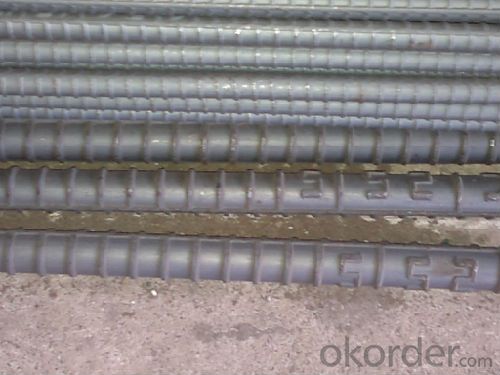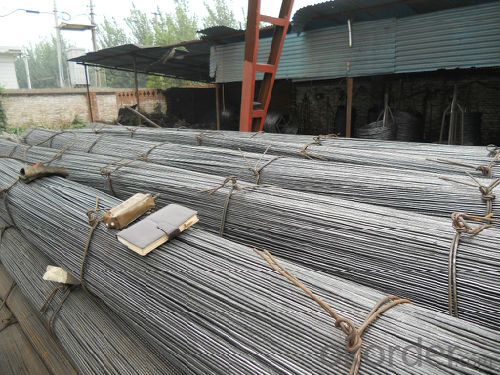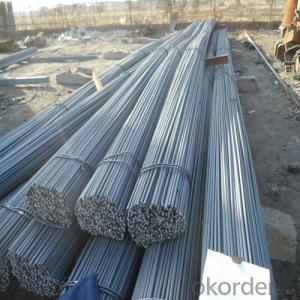Deformed Steel Bar Reinforced Deformed Steel Bar HRB400
- Loading Port:
- Tianjin
- Payment Terms:
- TT or LC
- Min Order Qty:
- 50 m.t.
- Supply Capability:
- 50000 m.t./month
OKorder Service Pledge
OKorder Financial Service
You Might Also Like
Product Description:
OKorder is offeringDeformed Steel Bar Reinforced Deformed Steel Bar HRB400 at great prices with worldwide shipping. Our supplier is a world-class manufacturer of steel, with our products utilized the world over. OKorder annually supplies products to European, North American and Asian markets. We provide quotations within 24 hours of receiving an inquiry and guarantee competitive prices.
Product Applications:
Deformed Steel Bar Reinforced Deformed Steel Bar HRB400 are ideal for structural applications and are widely used in the construction of buildings and bridges, and the manufacturing, petrochemical, and transportation industries.
Product Advantages:
OKorder's Deformed Steel Bar Reinforced Deformed Steel Bar HRB400 are durable, strong, and resist corrosion.
Main Product Features:
· Premium quality
· Prompt delivery & seaworthy packing (30 days after receiving deposit)
· Corrosion resistance
· Can be recycled and reused
· Mill test certification
· Professional Service
· Competitive pricing
Product Specifications:
Standard | GB | HRB400 | |
Diameter | 6mm,8mm,10mm,12mm,14mm,16mm,18mm,20mm, 22mm,25mm,28mm,32mm,36mm,40mm,50mm | ||
Length | 6M, 9M,12M or as required | ||
Place of origin | Hebei, China mainland | ||
Advantages | exact size, regular package, chemical and mechanical properties are stable. | ||
Type | Hot rolled deformed steel bar | ||
Brand name | DRAGON | ||
Chemical Composition: (Please kindly find our chemistry of our material based on HRB500 as below for your information)
Grade | Technical data of the original chemical composition (%) | ||||||
C | Mn | Si | S | P | V | ||
HRB400 | ≤0.25 | ≤1.60 | ≤0.80 | ≤0.045 | ≤0.045 | 0.04-0.12 | |
Physical capability | |||||||
Yield Strength (N/cm²) | Tensile Strength (N/cm²) | Elongation (%) | |||||
≥400 | ≥570 | ≥14 | |||||
Theoretical weight and section area of each diameter as below for your information:
Diameter(mm) | Section area (mm²) | Mass(kg/m) | Weight of 12m bar(kg) |
6 | 28.27 | 0.222 | 2.664 |
8 | 50.27 | 0.395 | 4.74 |
10 | 78.54 | 0.617 | 7.404 |
12 | 113.1 | 0.888 | 10.656 |
14 | 153.9 | 1.21 | 14.52 |
16 | 201.1 | 1.58 | 18.96 |
18 | 254.5 | 2.00 | 24 |
20 | 314.2 | 2.47 | 29.64 |
22 | 380.1 | 2.98 | 35.76 |
25 | 490.9 | 3.85 | 46.2 |
28 | 615.8 | 4.83 | 57.96 |
32 | 804.2 | 6.31 | 75.72 |
36 | 1018 | 7.99 | 98.88 |
40 | 1257 | 9.87 | 118.44 |
50 | 1964 | 15.42 | 185.04 |
Usage and Applications of HRB400 Deformed Steel Bar:
Deformed bar is widely used in buildings, bridges, roads and other engineering construction. Big to highways, railways, bridges, culverts, tunnels, public facilities such as flood control, dam, small to housing construction, beam, column, wall and the foundation of the plate, deformed bar is an integral structure material. With the development of world economy and the vigorous development of infrastructure construction, real estate, the demand for deformed bar will be larger and larger..
Packaging & Delivery of HRB400 Deformed Steel Bar:
Packaging Detail: products are packed in bundle and then shipped by container or bulk vessel, deformed bar is usually naked strapping delivery, when storing, please pay attention to moisture proof. The performance of rust will produce adverse effect.
Each bundle weight: 2-3MT, or as required
Payment term: TT or L/C
Delivery Detail: within 45 days after received advanced payment or LC.
Label: to be specified by customer, generally, each bundle has 1-2 labels
Trade terms: FOB, CFR, CIF
FAQ:
Q1: Why buy Materials & Equipment from OKorder.com?
A1: All products offered byOKorder.com are carefully selected from China's most reliable manufacturing enterprises. Through its ISO certifications, OKorder.com adheres to the highest standards and a commitment to supply chain safety and customer satisfaction.
Q2: How do we guarantee the quality of our products?
A2: We have established an advanced quality management system which conducts strict quality tests at every step, from raw materials to the final product. At the same time, we provide extensive follow-up service assurances as required.
Q3: How soon can we receive the product after purchase?
A3: Within three days of placing an order, we will begin production. The specific shipping date is dependent upon international and government factors, but is typically 7 to 10 workdays.
Images:



- Q:What is the effect of moisture on steel rebars?
- The effect of moisture on steel rebars can be significant and can lead to various issues. Moisture can accelerate the corrosion process of steel rebars, causing them to rust and deteriorate over time. This corrosion weakens the structural integrity of the rebars and can lead to structural failures in concrete structures. When steel rebars are exposed to moisture, the water reacts with the iron in the steel, causing an electrochemical reaction known as corrosion. This reaction produces iron oxide or rust, which expands and causes the rebars to crack and spall. As the corrosion progresses, the rebars lose their strength, which can compromise the overall stability of the structure. Moisture can also contribute to the formation of carbonation in concrete, which further increases the risk of corrosion for steel rebars. Carbonation occurs when carbon dioxide from the atmosphere reacts with the calcium hydroxide in concrete, reducing the alkalinity of the concrete. This reduction in alkalinity lowers the passivation of the rebars, making them more susceptible to corrosion. In addition to corrosion, moisture can also lead to other problems such as concrete expansion, freeze-thaw damage, and efflorescence. When moisture enters the concrete and freezes, it expands, causing cracking and spalling. This freeze-thaw cycle can further accelerate the corrosion process of steel rebars. Efflorescence, on the other hand, is the crystalline deposit that forms on the surface of concrete when moisture evaporates and leaves behind salts. This white, powdery substance can degrade the appearance of concrete structures and indicate potential moisture-related issues. To mitigate the effects of moisture on steel rebars, various preventive measures can be taken. These include using corrosion-resistant rebars, applying protective coatings or membranes to the rebars, ensuring proper concrete cover over the rebars, and implementing proper drainage systems to prevent the accumulation of moisture. Regular inspections and maintenance are also crucial to identify and address any moisture-related issues before they escalate and cause structural problems.
- Q:The difference between round face and round bar steel on concrete
- Round bar is divided into three parts: hot rolling, forging and cold drawing. Standard Specification for hot rolled round steel is 5.5-250 mm. Of which: 5.5-25 mm small round bars are mostly supplied by straight strips. They are used as reinforcing bars, bolts and various mechanical parts, and more than 25 millimeters of round steel. They are mainly used in the manufacture of mechanical parts or seamless steel tube billets.
- Q:What are the safety precautions to be taken while handling steel rebars?
- When handling steel rebars, there are several safety precautions that should be taken. These include wearing appropriate personal protective equipment (PPE) such as gloves, safety glasses, and steel-toed boots to protect against potential injuries. It is also essential to ensure proper lifting techniques are used to prevent strains or back injuries. Additionally, rebars should be properly stored and secured to avoid any hazards associated with falling or shifting materials. Regular inspections of the rebars for any damage or defects should be conducted, and any faulty or compromised rebars should be replaced immediately. Finally, it is crucial to follow all safety guidelines and protocols established by the employer or construction site to minimize any potential risks or accidents.
- Q:What are the different types of steel rebars used in road bridges?
- There are primarily three types of steel rebars commonly used in road bridges: carbon steel rebars, epoxy-coated rebars, and stainless steel rebars. Carbon steel rebars are the most widely used type due to their high strength and cost-effectiveness. Epoxy-coated rebars are used in areas prone to corrosion, as the coating protects the steel from moisture and chemicals. Stainless steel rebars, on the other hand, provide excellent resistance to corrosion and are typically used in highly corrosive environments or for aesthetic reasons.
- Q:What is the process of reinforcing existing concrete structures with steel rebars?
- Enhancing the strength and durability of existing concrete structures with steel rebars involves a series of steps. To begin, a thorough assessment of the concrete structure is conducted to determine its condition and identify areas in need of reinforcement. This involves inspecting the concrete for cracks, signs of degradation, or any other structural issues. Once the areas requiring reinforcement are identified, the next step is surface preparation. This involves cleaning the concrete surface to remove any loose debris, dirt, or contaminants that could hinder the bonding of the rebars with the concrete. Various methods, such as pressure washing or sandblasting, can be used for this purpose. Following surface preparation, the rebars are strategically placed within the concrete structure. The positioning and spacing of the rebars are crucial to ensure optimal reinforcement and structural integrity. This is typically accomplished by drilling holes or creating channels in the concrete where the rebars will be placed. Afterward, the rebars are inserted into the holes or channels, ensuring proper alignment and securing. The rebars are typically cut to the required length and bent into the desired shape to meet the specific reinforcement needs of the structure. Once the rebars are in place, they are anchored or secured to the existing concrete by various means. This can be achieved through the use of epoxy adhesive, mechanical anchors, or embedding the rebars into fresh concrete poured around them. Finally, the concrete is restored to its original condition, covering the rebars and creating a smooth and even surface. This may involve patching up any holes or channels created during the reinforcement process and finishing the surface to match the surrounding concrete. In conclusion, the process of reinforcing existing concrete structures with steel rebars necessitates careful planning, proper surface preparation, precise placement of rebars, secure anchoring, and appropriate finishing to achieve a strengthened and long-lasting structure.
- Q:What is the ductility of steel rebars?
- The ductility of steel rebars refers to its ability to deform under tension without fracturing. Steel rebars are known for their high ductility, allowing them to withstand significant bending and stretching without breaking. This property makes them ideal for reinforcing concrete structures, where they can absorb and distribute loads effectively.
- Q:Can steel rebars be used in architectural or decorative concrete applications?
- Yes, steel rebars can be used in architectural or decorative concrete applications. They provide structural reinforcement and enhance the overall strength and durability of the concrete. Additionally, when properly designed and installed, steel rebars can be concealed or incorporated into the design, making them suitable for various aesthetic purposes in architectural or decorative concrete projects.
- Q:Can steel rebars be used in solar power plant construction?
- Yes, steel rebars can be used in solar power plant construction. Steel rebars are commonly used as reinforcement in concrete structures, including the foundations and structural components of solar power plants. They provide strength, durability, and stability to the construction, ensuring the long-term performance and safety of the solar power plant.
- Q:What is the effect of steel rebars on the electrical conductivity of concrete?
- Steel rebars have a significant effect on the electrical conductivity of concrete. As steel is a highly conductive material, the presence of steel rebars in concrete increases its overall electrical conductivity. This is due to the fact that steel rebars create a network of conductive paths throughout the concrete matrix, allowing for the easy flow of electrical current. The electrical conductivity of concrete is an important factor to consider, especially in applications where electrical grounding or conductivity is necessary. Steel rebars aid in providing a low-resistance pathway for electrical current, improving the overall electrical conductivity of the concrete structure. However, it is essential to note that the presence of steel rebars can also introduce potential challenges in certain scenarios. For instance, in electrical installations where insulation is required or in areas where electrical isolation is necessary, the conductivity provided by steel rebars may not be desired. In such cases, additional measures like insulation or isolation techniques need to be employed to prevent unwanted electrical currents from flowing through the concrete. Overall, the effect of steel rebars on the electrical conductivity of concrete is dependent on the specific requirements and applications of the concrete structure. Understanding the intended use and implementing appropriate measures accordingly will ensure that the electrical conductivity of the concrete meets the desired specifications.
- Q:High strength thread steel hrb400e 32 in diameter, is it special steel?
- According to the use of special steel, can be divided into high quality carbon steel, alloy steel, carbon tool steel, alloy tool (die) with steel, high-speed tool steel, bearing steel, spring steel (carbon spring steel and alloy spring steel), stainless steel (heat, acid) eight.
1. Manufacturer Overview |
|
|---|---|
| Location | |
| Year Established | |
| Annual Output Value | |
| Main Markets | |
| Company Certifications | |
2. Manufacturer Certificates |
|
|---|---|
| a) Certification Name | |
| Range | |
| Reference | |
| Validity Period | |
3. Manufacturer Capability |
|
|---|---|
| a)Trade Capacity | |
| Nearest Port | |
| Export Percentage | |
| No.of Employees in Trade Department | |
| Language Spoken: | |
| b)Factory Information | |
| Factory Size: | |
| No. of Production Lines | |
| Contract Manufacturing | |
| Product Price Range | |
Send your message to us
Deformed Steel Bar Reinforced Deformed Steel Bar HRB400
- Loading Port:
- Tianjin
- Payment Terms:
- TT or LC
- Min Order Qty:
- 50 m.t.
- Supply Capability:
- 50000 m.t./month
OKorder Service Pledge
OKorder Financial Service
Similar products
New products
Hot products
Related keywords




























